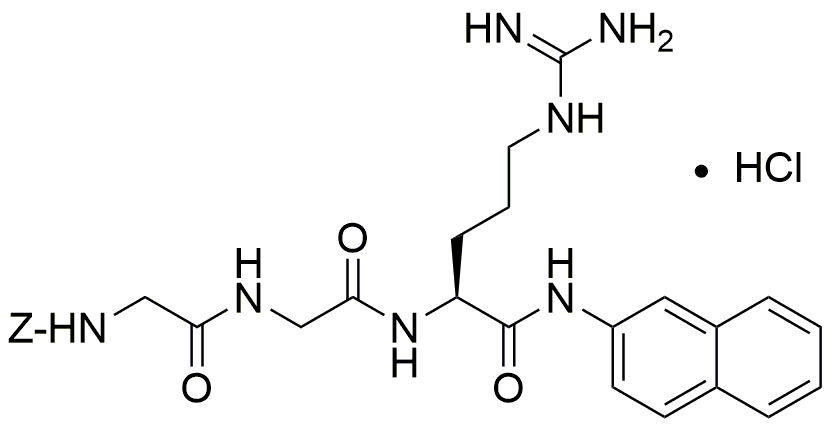Z-Gly-Gly-Arg-bNA·HCl is widely utilized in research focused on:
- Peptide Synthesis: This compound serves as a key building block in the synthesis of peptides, which are essential for developing new drugs and therapeutic agents.
- Biochemical Assays: It is commonly used in assays to study enzyme activity, particularly in the context of proteases, helping researchers understand protein interactions and functions.
- Drug Development: The compound plays a significant role in the formulation of novel pharmaceuticals, particularly in targeting specific biological pathways, enhancing drug efficacy.
- Diagnostic Applications: It is utilized in the development of diagnostic tools, aiding in the detection of various diseases through biomarker identification.
- Research on Cellular Processes: This chemical is instrumental in studies investigating cellular signaling pathways, contributing to advancements in cancer research and regenerative medicine.
General Information
Properties
Safety and Regulations
Applications
Z-Gly-Gly-Arg-bNA·HCl is widely utilized in research focused on:
- Peptide Synthesis: This compound serves as a key building block in the synthesis of peptides, which are essential for developing new drugs and therapeutic agents.
- Biochemical Assays: It is commonly used in assays to study enzyme activity, particularly in the context of proteases, helping researchers understand protein interactions and functions.
- Drug Development: The compound plays a significant role in the formulation of novel pharmaceuticals, particularly in targeting specific biological pathways, enhancing drug efficacy.
- Diagnostic Applications: It is utilized in the development of diagnostic tools, aiding in the detection of various diseases through biomarker identification.
- Research on Cellular Processes: This chemical is instrumental in studies investigating cellular signaling pathways, contributing to advancements in cancer research and regenerative medicine.
Documents
Safety Data Sheets (SDS)
The SDS provides comprehensive safety information on handling, storage, and disposal of the product.
Product Specification (PS)
The PS provides a comprehensive breakdown of the product’s properties, including chemical composition, physical state, purity, and storage requirements. It also details acceptable quality ranges and the product's intended applications.
Certificates of Analysis (COA)
Search for Certificates of Analysis (COA) by entering the products Lot Number. Lot and Batch Numbers can be found on a product’s label following the words ‘Lot’ or ‘Batch’.
*Catalog Number
*Lot Number
Certificates Of Origin (COO)
This COO confirms the country where the product was manufactured, and also details the materials and components used in it and whether it is derived from natural, synthetic, or other specific sources. This certificate may be required for customs, trade, and regulatory compliance.
*Catalog Number
*Lot Number
Safety Data Sheets (SDS)
The SDS provides comprehensive safety information on handling, storage, and disposal of the product.
DownloadProduct Specification (PS)
The PS provides a comprehensive breakdown of the product’s properties, including chemical composition, physical state, purity, and storage requirements. It also details acceptable quality ranges and the product's intended applications.
DownloadCertificates of Analysis (COA)
Search for Certificates of Analysis (COA) by entering the products Lot Number. Lot and Batch Numbers can be found on a product’s label following the words ‘Lot’ or ‘Batch’.
*Catalog Number
*Lot Number
Certificates Of Origin (COO)
This COO confirms the country where the product was manufactured, and also details the materials and components used in it and whether it is derived from natural, synthetic, or other specific sources. This certificate may be required for customs, trade, and regulatory compliance.


